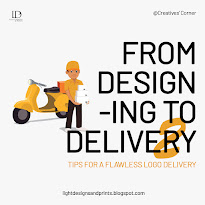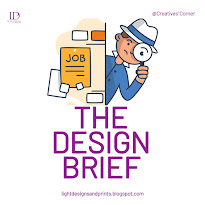Hey guys! It’s an awesome day for learning again. So, let’s
pick up from where we stopped. Now that you have gotten the inspiration to
create a logo for your client, how do you present it? What are the tips you
need to pull off a beautiful presentation to a logo approval? Let’s move
together.
1.
Avoid Intermediation
Let’s assume you are still in direct contact with the middle
man, and you need to present your ideas, you need to do it yourself. AVOID
INTERMEDIATION. Do not allow a third party to present your ideas and the reason
behind it is because he or she can’t sell you the same way you will sell
yourself. He or she won’t be able to answer questions directed at you the same
way you will. He or she won’t be able to defend your job the same way you will,
I hope you get me.
All you have to do is let the person see how much you want
to help him to not put him under pressure. So, let him help you get in front of
your client physically to help him out. In case the middle man wants to put up
resistance, one thing that works is to tell him or her that it is company
policy.
2.
Take Control
So now that you are in front of your client and the decision
committee, don’t forget to juggle their memory with the design brief. They are
doing a lot of things and will have forgotten all the details they gave you. You
can take a copy of the design brief with you. And while presenting, avoid using
designers jargon, don’t forget you are not talking to a designer like yourself,
you don’t want to lose your client’s concentration.
3.
Outline some ground rules
Hey there, you have created the logo, I know you did not go
to present so that you can be told the colour or font to use right? Let them
know from the beginning. You are the designer, the expert. Don’t be rude but
talk professionally. Let them know it’s not the time for them to start telling
you what to do, because if they do, their brand will be inevitably weakened.
Nobody wants that, you know?
4.
Don’t wait until the presentation
Okay this is quite funny but true. Let your clients see and
come to meet you as a doctor who creates time for them as they come in and not
as a waiter who has been waiting and that they talk to when they are ready to
order. Do you get? As much as possible, don’t let them keep you waiting, well
to avoid that, I suggest a payment per hour of your time they spend/waste, or
what do you think?
5.
Keep the committee involved
Remember you are likely to have a committee involved in the approval process. Ask them if they have something they are expecting, a pre-conceived idea so that if you don’t give them their individually preconceived idea, they won’t be disappointed and outrightly reject what you have brought. If there is a committee that consists of 8 people, you know you can’t satisfy them all as regard their pre-conceived ideas. So, you have to let them know that their pre-conceived ideas might be great but won’t be for the good of the company, so they have to listen to you with open minds.
6.
Make sure to under promise and over deliver
Make sure to factor your worst into your delivery time frame
and then impress them with early delivery. Wouldn’t that be better? Instead of
you disappointing your client because you gave a short delivery time frame,
it’s better to give a longer time, and deliver earlier.
7.
Swallow your pride
You should know that there will always be feedbacks, so
learn to listen to their feedbacks. It is rare for you to deliver a logo and it
will be not get some adjustments from the clients, it happens sometimes though.
In lieu of this, be open to feedbacks, both good and bad.
Well, I believe that with these few tips for presenting your
logo idea, you will be able to pull off your logo delivery and get an approval.
I hope you learnt again? Please don’t forget to send in your
feedbacks, I am open to them. For topics you want me to talk about, please send
me a mail on olamipoada2@gmail.com.
For my next post, I will be talking about an important
topic: HOW TO PRICE YOUR CLIENTS. Watch out!
See ya!




















